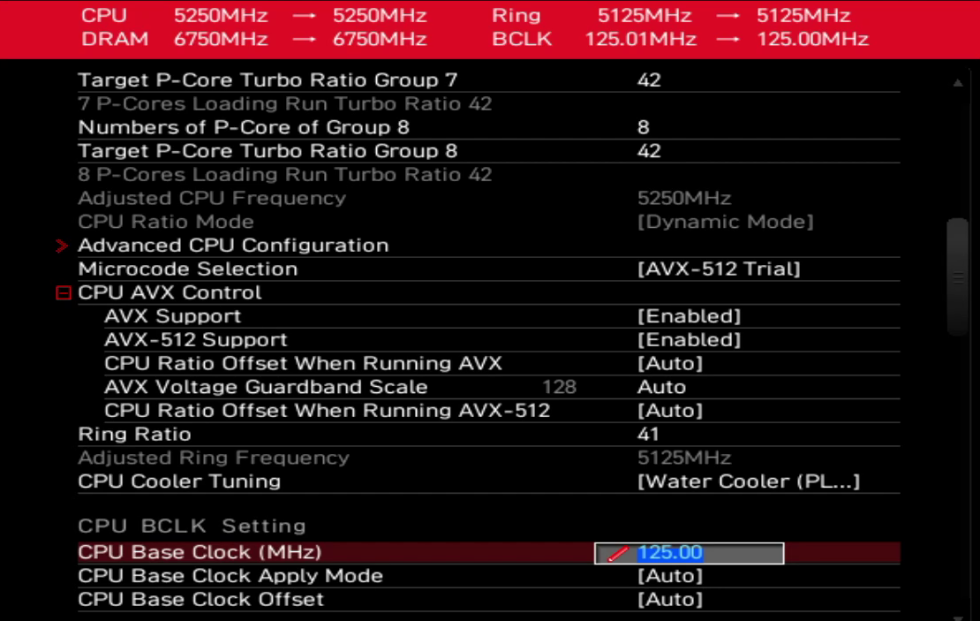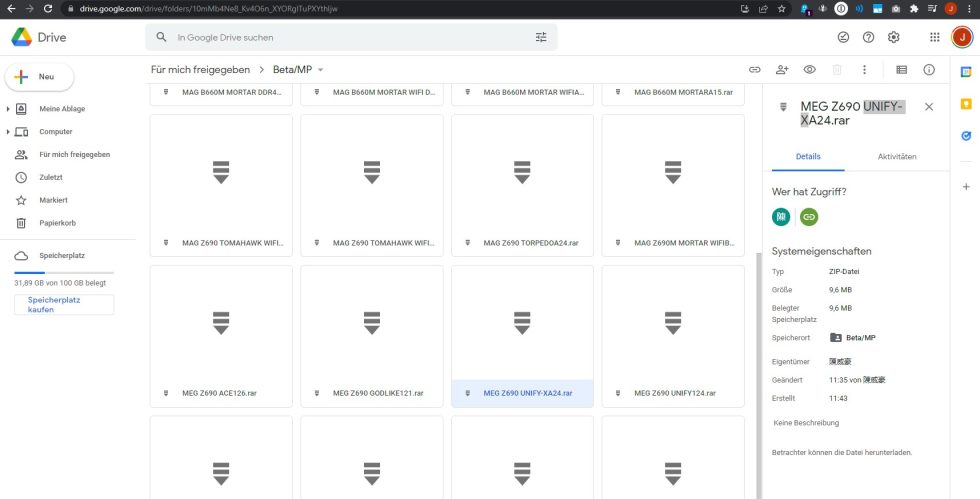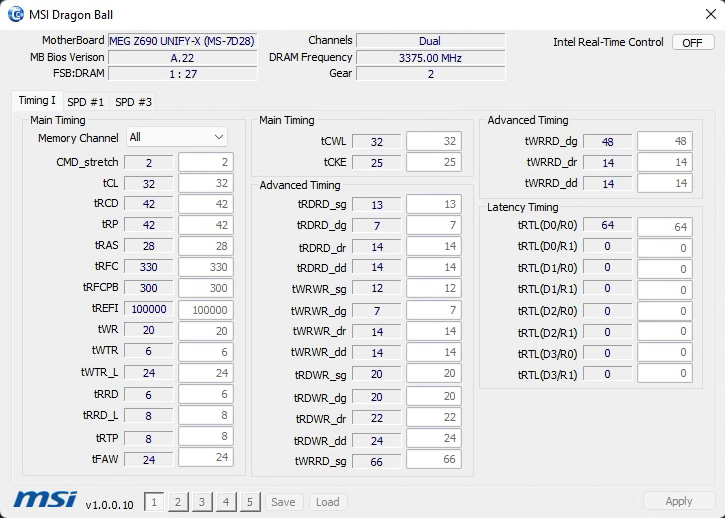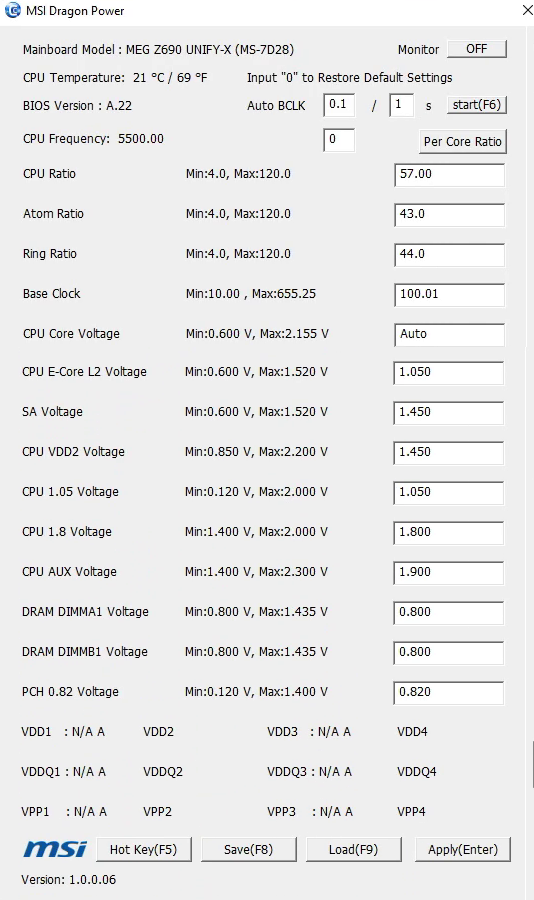Tuning controller
If you have already read my review of the Z590 Unify-X, you will know that I was not very enthusiastic the introduction of the “Tuning Controller” as a replacement for onboard buttons for Retry, Safeboot and co., especially because it simply did not work for me and MSI has not sent me a replacement part to this day (bought it myself, no sample). But anyway, I just wanted to briefly describe my expectations.
To my surprise, however, the tuning controller works smoothly on the Z690 Unify-X and turns out to be surprisingly practical with its features. The + and – buttons can be freely set in the BIOS to BCLK steps of a minimum of 0.01 MHz, which is more granular and thus better than any other motherboard I’ve had in my tests.
I prefer to run the Tuning Controller without its case and as a bare PCB. Of course, you now have to be careful where you place it so that the solder joints don’t cause a short circuit, but the postal code is much easier to read from larger viewing angles and is also very bright. In addition, I personally like the board itself with the yellow labels better than the plastic case. By the way, if the cable that connects the tuning controller to the board is too short, you can of course extend it relatively easily with a little manual work and some soldering magic.
BIOS Layout and Usability
In terms of menu layout and clarity, MSI was already the best in class in past generations and this continues with the Z690. The various BIOS options are sensibly divided into menus and there again into submenus, which can be folded in and out, as well as skipped in whole blocks with the left and right arrow keys.
However, I would like to mention a few minor flaws, because sometimes not all settings are applied directly as set. For example, 1.35 V System Agent is set, but after F10 and reboot, only 0.9 V = Auto is present. An equally annoying little problem is the hanging of the mail process after the system has crashed due to a blue screen. In both cases, only a cold boot helps, i.e. completely shutting down the system by holding the power button for a long time or switching off the power supply and then restarting it. So there is still a gremlin somewhere in the BIOS code when loading the settings, which MSI will hopefully still be able to track down and sort out.
By the way, a hardware retry button like Asus’ could help here, where the board is started completely cold after pressing the button. But on the other hand, MSI has also built in many usability conveniences into the Unify-X, like the BCLK that can be adjusted by a minimum of 0.01 MHz with a direct preview in the BIOS of all clock rates affected by it. The support of a microcode selection and thus AVX-512 is also not self-evident since Intel had tried to disable the feature with an update afterwards.
Saving and loading profiles in the BIOS, on usb media, exporting screenshots and flashing new BIOS images also works flawlessly. The BIOS switch on the bottom edge of the board also does exactly what you would expect, without any annoying automatisms or the like, and shows with a red or white LED which of the two BIOS chips is currently active. Unfortunately, switching between chips resets all BIOS settings that are not saved as a profile. It is recommended to save the config state more often if you do not want to reconstruct it from your head. But as you can see, this is all really complaining at the highest level.
In-OS software and BIOS updates
MSI provides two portable programs for use with their overclocking boards, MSI Dragon Ball for viewing and adjusting RAM timings from the OS, and MSI Dragon Power, for adjusting voltages and clock speeds from within the OS. Both programs work without any installation and can be obtained from public Google Drives, which can be found relatively quickly after some research in overclocking forums. As always, a download from the official support website would be nicest, but you can’t have everything.
MSI also provides new BIOS releases quickly, regularly and reliably on said Google Drives and for versions intended for all users, they are also provided daily on the official support website. Even though this might not sound like anything special at first, MSI is also very far ahead in the market segment of overclocking hardware with this.
The MSI Dragon Ball software also works without any major problems and adjusting timings at runtime is intuitively possible – with platform-dependent restrictions of individual timings like tWR or tRTP. Unfortunately, there is still a display bug with the RTLs that only 1 of the 4 subchannel RTLs are displayed. However, other software tools like the popular Asrock Timing Configurator can read them completely. So MSI could also go on a bug search again here.
MSI’s Dragon Power software is also not completely bug-free and could use some more fine-tuning for the Z690 platform. The most important functions like changing the multipliers and setting the core voltage work fine, but for example when setting the core voltage, in some cases the LLC is reset to level 1, which of course has a significant impact on the applied voltage under load. I could not yet figure out what exactly triggers this behavior. But in any case, you should keep this in mind when overclocking from the OS. Also, the RAM voltages VDD and VDDQ cannot be changed above the JEDEC specified 1.435 V, which is not very useful for overclocking. On the other hand, then a re-training of the memory is necessary anyway – so this is not a big deal either.






































5 Antworten
Kommentar
Lade neue Kommentare
Urgestein
Veteran
Veteran
Veteran
Veteran
Alle Kommentare lesen unter igor´sLAB Community →